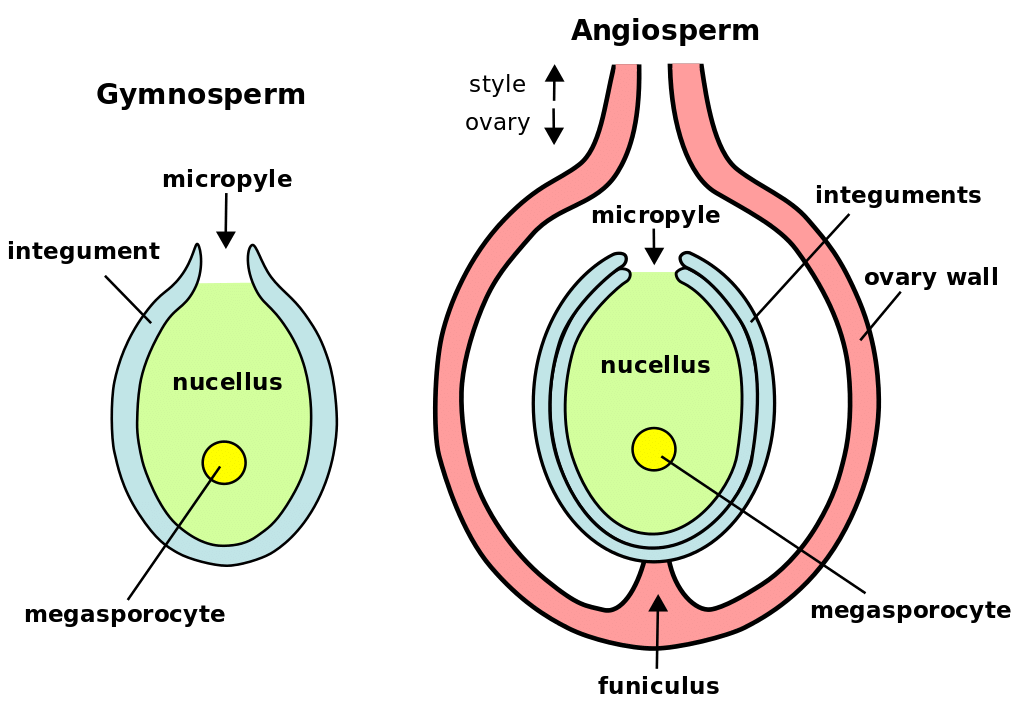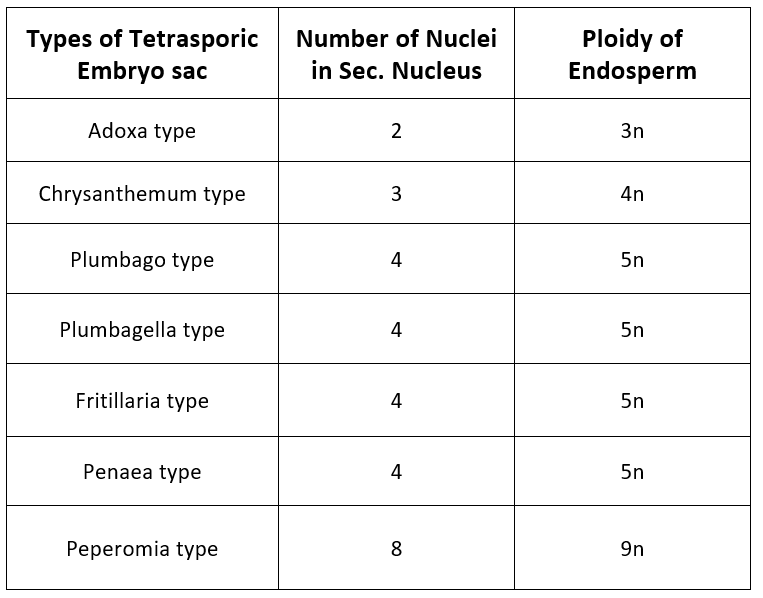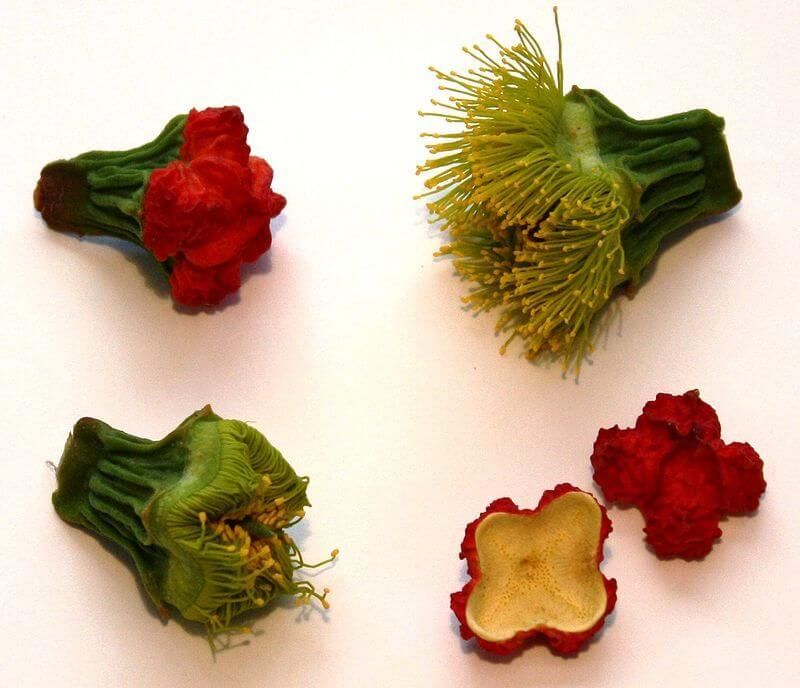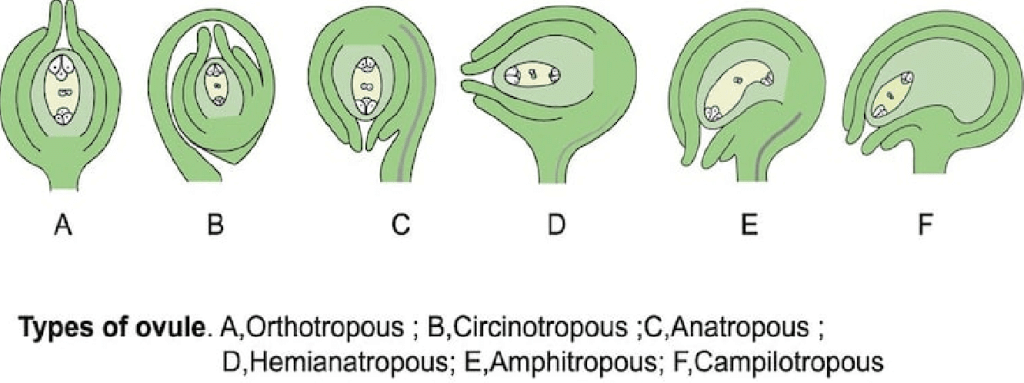Megasporangia (Ovule) and Megasporogenesis | Biology for Grade 12 PDF Download
| Table of contents |

|
| Structure of Ovule or Megasporangium |

|
| Megasporogenesis |

|
| Development of Embryo sac |

|
| Types of Embryo Sacs |

|
Angiosperms are a group of vascular plants, meaning they have specialized tissues for conducting water, nutrients, and sugars. Angiosperms are heterosporous, meaning they produce both megaspores and microspores. Megaspores develop into female gametophytes, and microspores become pollen grains—the male gametophytes.
Formation of female gametophyte from microsporangium is explained below
Structure of Ovule or Megasporangium
Megasporangia are structures in plants that produce megaspores through meiosis in a process called megasporogenesis. In seed plants, the megasporangium is the ovule, located within the ovary of angiosperms or the female cone of gymnosperms.
 Structure of Megasporangium
Structure of Megasporangium
The ovule has three main components: integuments (outer layers), nucellus (inner cell mass with sporophytic cells), and the embryo sac. The megaspore mother cell undergoes meiosis in the nucellus, resulting in four cells, one of which becomes a megaspore. In angiosperms, this megaspore develops into the embryo sac, the megagametophyte or female gametophyte.
- A ridge or stalk-like outgrowth is formed from the placenta of the ovary on which the body of ovules is present. Each ovule is attached to the placenta by means of a thin stalk called a funicle or funiculus. The point of attachment of the funicle with the ovule is called Hilum.
- The main region of the ovule is composed of mass of parenchymatous cells called the nucellus. The nucellus is the main part of the ovule. The nucleus is covered by one or two coats called integuments.
- In most of the ovule, the funicle is attached to the main body of the ovule for some distance (at the lateral side) to form a ridge-like structure known as Raphe.
- Vascular tissues are present inside the funiculus which supply food material from the placenta to the body of the ovule.
- A place from where funicle and integuments arise is called Chalaza.
- The integument is absent just opposite to the chalaza so that a narrow passage (pore) is formed which is called the micropyle.
Anatropous Ovule
- In this type, the body of the ovule completely turned at 1800 angle, due to unilateral growth of funiculus, so it is also called an inverted ovule.
- The chalaza and micropyle lie in a straight line. The hilum and micropyle lie side by side very close to each other. This type of ovule is found in 80% of families of Angiosperms but not in Capsella. In this ovule micropyle facing a downward condition.
- This is the most common type of ovule so that it is considered as a "typical ovule" of Angiosperms.
Examples: Members of Malvaceae, Cucurbitaceae, Solanaceae, Composite family. - It is also called a resupinate ovule.
Megasporogenesis
- During the development of the ovule, at the beginning of this process, the nucleus develops from the placenta in the form of a small rounded outgrowth like structure.
- At this stage, all the cells of the nucleus are undifferentiated, homogeneous and meristematic. This mass of cells surrounded by a single-celled thick layer of the epidermis.
 Plant ovules with megasporocytes before meiosis: Gymnosperm ovule on left & Angiosperm ovule (inside ovary) on right
Plant ovules with megasporocytes before meiosis: Gymnosperm ovule on left & Angiosperm ovule (inside ovary) on right - Any one hypodermal cell of the nucleus is differentiated and increase in size. It becomes different from the rest of the cells due to the presence of a distinct nucleus. It is called an archesporial cell.
- Archesporium divides periclinally to form an outer primary parietal cell and inner Primary Sporogenous cell. The activity of the Primary Parietal cell depends on the type of plants.
- If the plant belongs to gamopetalae then it forms a tenuinucellate type ovule and if the plant belongs to polypetalae then it forms crassinucellate type of ovule. The primary sporogenous cell directly acts as a megaspore mother cell.
- It divides meiotically to form, four haploid megaspores. The four haploid megaspores generally arranged in a linear tetrad. Generally, the lowermost or chalazal megaspore remains functional out of tetrad of megaspores and the other three lie towards the micropyle degenerate.
- This functional megaspore produces female gametophyte. In most Angiosperms [Capsella], the Chalazal megaspore remains functional.
Development of Embryo sac
- The megaspore is the first cell of the female gametophyte. This megaspore grows in size and obtains nutrition from the nucleus. The nucleus of the megaspore divides mitotically to form two nuclei.
- Each nucleus moves towards the opposite pole and reached at their respective poles. Both the nuclei lie at poles divide twice mitotically. Resulting, four-four nuclei are formed at each pole (Total 8-nuclei).
 Development of Female Gametophyte
Development of Female Gametophyte
- Out of the four, one-one nucleus migrates from both poles (one nucleus from the chalazal side and one nucleus from the micropylar side) towards the centre. They are known as polar nuclei. Both polar nuclei are present in the centre.
- The remaining three-three nuclei at each pole surrounded by cytoplasm to form cells as a result of cytokinesis. Three cells are formed towards the micropyle in which one cell is large and more distinct out of three cells. This is called the egg cell and the remaining two smaller cells are known as synergids.
- These three micropylar cells are collectively known as egg-apparatus (1 Egg cell + 2 Synergids). The three cells are formed toward the Chalaza are called antipodal cells. Both the polar nuclei present in the central cell. But just before the process of fertilization they unite or fuse together in the centre to form the secondary nucleus. It is diploid in nature (2n) and one in number.
- Therefore, seven cells and eight nucleated structure is formed. This eight nucleated and seven celled structure is called the female gametophyte or embryo sac of Angiosperms. This type of embryo sac is known as the "polygonum type" because it is discovered by Strasburger in the Polygonum plant.
- Polygonum type embryo sac is the most common type in Angiosperms (Capsella). Polygonum type of embryo sac develops from single megaspore so it is also known as monosporic embryo sac.
- Fingers like processes are produced from the outer wall of the synergids are known as filiform apparatus. With the help of these structures, synergids absorb food from the nucleus and transfer it to the embryo sac. Filiform apparatus is less developed in antipodal cells. Filiform also secrete chemicals that attract the pollen tube.
Types of Embryo Sacs
 Monosporic, Bisporic and Tetrasporic Embryo Sac
Monosporic, Bisporic and Tetrasporic Embryo Sac
- Monosporic Embryo sac
It is of two types:
(i) Polygonum type: It is an eight nucleated and seven celled embryo sac.
(ii) Oenothera type: Exceptionally it is four nucleated in which only one nucleus in a central cell and three nuclei in the egg apparatus. Antipodal cells are absent. Endosperm will become diploid. Micropylar megaspore becomes functional. - Bisporic Embryo sac
It is formed by two megaspores. It means it develops from two nucleated megaspores.
It is of three types:
(i) Allium type: Eight nucleated and seven celled Chalazal megaspores.
(ii) Endymion type: Eight nucleated and seven celled Micropylar megaspores.
(iii) Tetrasporic type: It is formed by all four megaspore nuclei because meiosis is not accompanied by Cytokinesis so that four nuclei of megaspores are formed. All four nuclei are collectively known as "Coeno-megaspore".
Generally, all the four Nuclei of megaspores take part in the formation of the seven celled and eight nucleated embryo sac.
Old Syllabus NCERT
Some other Types of Embryo Sacs
- Beside the above types of embryo sac, different other types of embryo sacs are also formed. Arrangement of nuclei are not definite in embryo sac in some Angiosperms.
- So, that different type of embryo sacs are formed as follows:

Special Integuments
(i) Aril: It is the type of third integuments that develops from the funicle at the base of the ovule.
Example: Myristica, Asphodelus and Litchi.
(ii) Arillode: It develops from the tips of the outer integument and grows downwards and surrounds the entire ovule.
Example: Pithecellobium (Inga dulce).
(iii) Sarcotesta: When the outer integument becomes fleshy then it is called Sarcotesta.
Example: Magnoliaceae (Magnolia).
(iv) Operculum: It is a stopper or break like structure that is formed on the micropyle. It is formed due to the elongation of inner integuments.
Example: Lemnaceae family (Lemna). The flower buds of Eucalyptus erythrocorys have a large, bright red operculum. (v) Caruncle or Strophiole: It is formed due to the proliferation (outgrowth) of outer integuments over the micropyle.
The flower buds of Eucalyptus erythrocorys have a large, bright red operculum. (v) Caruncle or Strophiole: It is formed due to the proliferation (outgrowth) of outer integuments over the micropyle.
Example: Ricinus communis (Castor).
It is formed by sugary contents so helps in the absorption of water during the germination of seeds and dispersal of seeds by ants called myrmecochory.
(vi) COMA: In some of the plants, unicellular filaments like structures are present on the seed which is formed by cells of the outer surface of the outer integument. Such seeds are known as "Comose seeds".
Example: Calotropis and Gossypium.
Types of Ovule on the Basis of Integuments
- A single integumented ovule is called a unitegmic ovule.
Example: Members of Gamopetalae and Gymnosperm. - Two integumented ovule is called a bitegmic ovule.
Example: In most of Angiosperms (Polypetalae-Capsella and Monocots). - The ovule in which integuments are absent is called Ategmic ovule.
Example: Olax, Liriosma, Loranthus & Santalum.
Types of Ovule on the Basis of Nucleus
(i) Tenuinucellate: The nucleus is either less developed or present in the form of a single layer.
Example: Gamopetalae group.
(ii) Crassinucellate: The nucleus is a massive type i.e., it is made up of many layers.
Example: Polypetalae group and Monocots.
The nucleus degenerates in plants of the Composite family and integuments becomes active to form a nucleus like tissue. This is called endothelium or integumentary tapetum. It is a polyploid structure.
The nucleus dissolves in the members of the Podostemaceae family to form a nutritional cavity. This is termed pseudo-embryo-sac.
Types of Ovules on the Basis of Structure
- There are six different types of ovules are found in Angiosperms on the basis of the relationship of the micropyle, chalaza, and hilum with the body of the ovule and orientation on the funiculus.

(i) Atropous or Orthotropous
- The body of the ovule is upright in position. The micropyle, chalaza and hilum lie in one straight line so that this ovule is called a straight or upright ovule.
Examples: Betel, Piper, Polygonum and in Gymnosperms. - It is the most primitive and most simple type of ovule of Angiosperms. Raphe is absent.
(ii) Anatropous Ovule
- In this type, the body of the ovule completely turned at 1800 angle, due to unilateral growth of funiculus, so it is also called an inverted ovule.
- The chalaza and micropyle lie in a straight line. The hilum and micropyle lie side by side very close to each other. This type of ovule is found in 80% of families of Angiosperms but not in Capsella. In this ovule micropyle facing a downward condition.
- This is the most common type of ovule so that it is considered as a "typical ovule" of Angiosperms.
Examples: Members of Malvaceae, Cucurbitaceae, Solanaceae, Composite family. - It is also called a resupinate ovule.
(iii) Hemitropous or Hemi-Anatropous Ovule
- In this ovule, the body of the ovule bent on funcile at 900 angle, i.e., the body of ovule present at a right angle to the funiculus. This is an intermediate type between ortho and anatropous ovules.
- This ovule is also called horizontal ovule because the body of the ovule present in a horizontal position on the funiculus. Micropyle and chalaza are present in the same line but micropyle is situated away from the hilum.
Examples: Ranunculus, Primula, Golphimia.
(iv) Campylotropous Ovule
- In this ovule, the body of ovule curved (Curvature is not effective) in this way so micropyle and chalaza do not present in a straight line.
- The nucleus is present in a curved position but the embryo sac remains straight. Micropyle comes close to the hilum.
Examples: Leguminosae, Capparidaceae, Cruciferae family (Capsella).
(v) Amphitropous Ovule
- In this type of ovule, the curvature is more pronounced or effective in the nucellus and due to this effect of the nucellus, the embryo sac becomes horseshoe-shaped.
- Micropyle comes close to the hilum. It is also called as transverse ovule.
Examples: Mirabilis, Lemna, Poppy, Alisma, Butomaceae family.
(vi) Circinotropous Ovule
- In this type of ovule, the body of the ovule inverted and again turned into a straight position due to the growth of the funiculus so that body of the ovule present on the funicle at 3600.
- The entire body of the ovule is surrounded by funiculus. It is also known as a coiled ovule. The micropyle is situated away from the hilum.
Example: Cactaceae family - Opuntia.
|
124 videos|215 docs|236 tests
|
FAQs on Megasporangia (Ovule) and Megasporogenesis - Biology for Grade 12
| 1. What is the structure of the ovule or megasporangium? |  |
| 2. What is megasporogenesis? |  |
| 3. How does the embryo sac develop? |  |
| 4. What are the types of embryo sacs? |  |
| 5. What is the function of the ovule or megasporangium? |  |
















